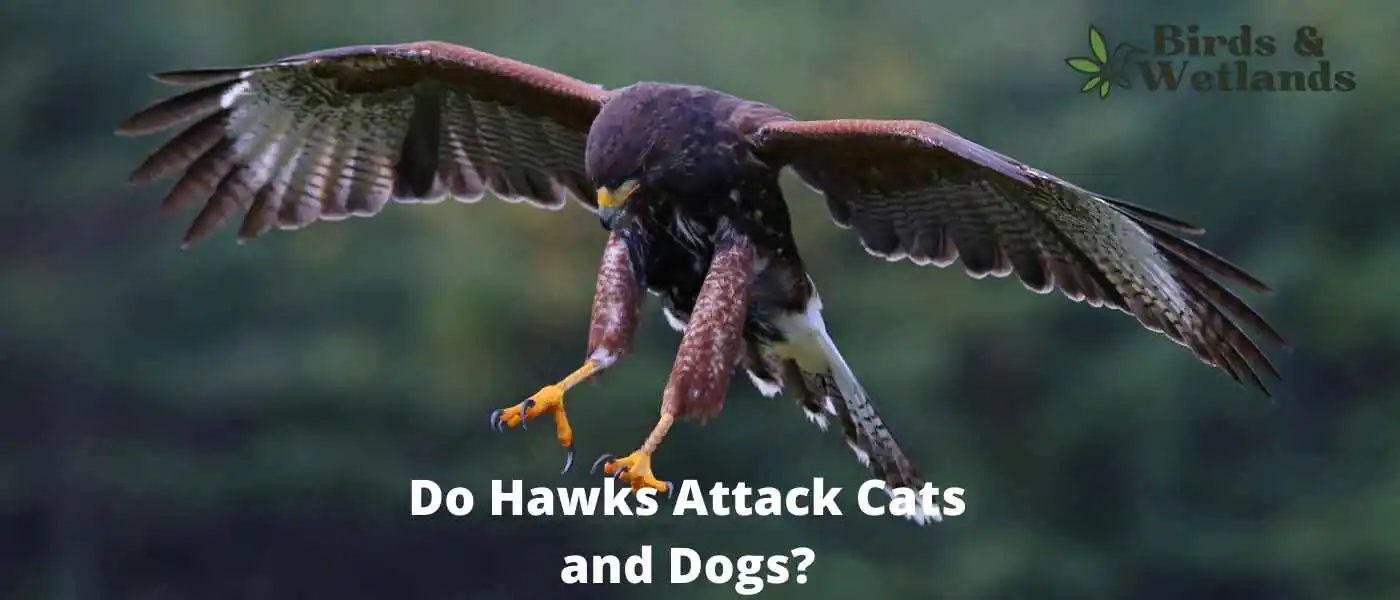Hawks are normally shy around humans, but they will attack and eat small dogs and cats if they are hungry enough. This is most likely to happen if the hawk is a mother with chicks to feed, but even young hawks have been known to target small pets.
While cats are generally larger than the hawk’s natural prey, they are not immune to being eaten. If you have a small pet, it is best to keep it indoors or in a securely fenced area, especially during the spring and summer when red-tailed hawks are more active.
Red-tailed hawks typically hunt during the day and kill prey on the ground, so keeping your pet inside at night will also reduce the risk of attack.
However, it is important to remember that hawk attacks are rare, and most raptors will avoid contact with humans if possible (the same as falcons rarely attack humans). But even so, always make sure to keep your pet dog and cat safe.
Why Would a Hawk Attack a Dog?
Hawks are typically shy around humans, but they are fiercely protective of their young. If a cat or a dog wanders too close to a hawk’s nest, the hawk may see the dog as a threat and attack. In most cases, the hawk will simply swoop down and scare the dog away.
If the hawk feels that its nest is truly threatened, it may launch a more serious attack.
Hawks have sharp claws and beaks, and they can cause serious injuries to small animals. For this reason, it is best to keep dogs away from hawks’ nests. If you see a hawk nesting in your area, make sure to keep your dog on a leash and supervise them closely when they are outside.
Can a Hawk Pick Up a 15-Pound Dog?
Hawks are predators that rely on their speed and agility to catch their prey. While they can take down larger animals, such as deer or rabbits, they typically prefer to hunt smaller prey, such as rodents or birds.
Hawks have relatively small body sizes and weak legs, which limits their carrying capacity to only about five pounds. Most hawks can only carry up to their own body weight. As a result, a 15-pound dog would be too heavy for a large hawk to carry off, and the bird would likely be injured in the process.
Even large hawks avoid open areas where they would be vulnerable to attack from other predators. What this means is that even Cooper’s hawks are less likely to carry your massive-sized dog. After all, a Cooper’s Hawk is too small.
How to Protect Your Pets From Hawk Attacks?
Many birds of prey attack other animals such as backyard birds and small pets. Large raptors, for instance, have been known to catch prey larger than them. And if smaller animals are scarce, they will occasionally view pets such as a cat or a small dog as a viable food source.
Large cats and dogs are probably safe from large hawks. But most cats and other dogs that are small can be vulnerable to larger hawks.
Keep Small Dogs and Cats Indoors
To help prevent raptor attacks, pet owners should never leave their small dogs and cats unsupervised outdoors. If possible, keep your small dog and cat inside or in a secure enclosure when not under direct supervision.
If they must be outside, keep them close by and be aware of their surroundings. If a hawk does attack, try to scare it off by waving your arms or throwing something at it.
Remove Bird Feeders
Bird feeders are a great way to bring some feathered friends into your yard, but they can also attract hawks looking for an easy meal. If you have small pets, such as cats or rabbits, it’s important to take measures to protect them from these predators.
One way to do this is by removing bird feeders from your property. Hawks are attracted to areas where there is a concentration of animals, and by removing low feeders you can make your yard less attractive to them.
Likewise, don’t leave bird seed on the ground to avoid attracting wild birds to your yard.
Build a Covered Enclosure for Your Pets
One of the most effective ways to prevent hawk attacks is to build a covered enclosure for your pets. This will provide them with a safe space to stay while still allowing them to enjoy the outdoors.
It is also important to keep an eye on your pets when they are outside, as hawks are more likely to attack if they think that they can do so without being seen.
Avoid Bird-Watching Areas
If you’re going for a walk, avoid bird-watching areas. These locations are probably being watched by hawks perched on nearby trees.
Do Hawks Eat Cats?
So, hawks eat cats? While it’s not a common occurrence, there have been cases of hawks preying on cats. Most hawks are typically attracted to small, quick-moving prey, and cats fit this description. In addition, hawks have sharp talons and beaks that can easily kill a cat.
However, there are several factors that make it unlikely for a hawk to prey on a cat.
Cats are relatively rare in the wild and most hawks live in rural areas where there are fewer cats. Additionally, hawks typically hunt small mammals during the day, while cats are more active at night.
For all these reasons, while it’s possible for hawks to eat cats, it happens relatively rarely. While cats are not typically part of a hawk’s diet, keep your cat indoors during the day just to be safe.
Conclusion on Hawks Attacking Pets
While it is certainly rare for hawks to attack cats and dogs, it does happen on occasion. If you live in an area where hawks are common, it’s important to be aware of the potential danger and keep your pets close by.
Hawks are opportunistic predators and will take advantage of any opportunity they have to catch food, so it’s best not to give them one by letting your pet wander too close to their nests or territory.
If you notice smaller hawks or large birds of prey nearby, make sure to keep your small dog or cat inside and don’t let your pet wander off especially in the early morning when most of these raptors are active.
Talk to a licensed veterinarian that can provide veterinary advice on how to keep your pet cat or dog safe from other threats.
FAQs on Would a Hungry Hawk Attack Pets
Is It Good to Have a Hawk in Your Yard?
Hawks are top predators in the bird world, so their presence indicates a well-functioning ecosystem. They require a lot of open space and need large territories to find enough food to survive. A backyard that can support a hawk is likely also provide ample opportunities for other birds to nest and forage.
In addition, hawks help to control the rodent population and extra animals that can damage bird eggs and nests. Having hawks in your backyard is a sign that your property is providing ideal conditions for birds.
So, even though they may not be the prettiest visitors, attracting hawks is a sure sign that you’re creating a bird-friendly environment.
What Attracts Hawks in Your Yard?
Hawks are typically attracted to backyards that offer a plentiful supply of prey, such as rodents or small birds. In some cases, however, the presence of humans may also be a factor.
Hawks are naturally curious creatures, and they may be drawn to backyards where there is a lot of activity. They may also be attracted to backyards that offer a good vantage point, such as those with tall trees.
Can You Remove the Hawk’s Nest From Your Yard?
Hawks are a protected species under state and federal laws, so it is illegal to remove their nests without a permit. Furthermore, it is important to wait until the chicks have grown and fledged before removing the nest, as this is the only time that the parents will abandon the nest.
If the nest is removed while the chicks are still young, they will almost certainly die. In addition, there is a danger that the parents will become agitated and attack people who are near the nest.
For these reasons, it is best to wait until the eggs hatch and the hawk chicks have grown before attempting to remove a hawk’s nest from your yard.
What Other Raptors That Hunt Pets?
Raptors such as a sharp-shinned hawk, great-horned owl, and golden eagle are typically known to attack small animals such as rodents and rabbits. However, there have been several instances where these predators have attacked larger animals, including pets.
Golden eagles, for example, have been known to attack full-grown deer and even humans. Great-horned owls have also been known to target larger prey, and have been documented attacking a dog, cat, and a pony. In most cases, these attacks are motivated by hunger or territoriality.
However, there have also been reports of raptors attacking animals that they perceive to be a threat to their young. While these incidents are relatively rare, they underscore the importance of being aware of the dangers these birds can pose.
What Other Pets Are at Risk From Raptors?
Pets that are in danger of attacks from birds of prey include a domesticated cat and kittens, small dogs and puppies, ducks, guinea pigs, rabbits, and hawks will eat chickens. These animals are at risk because they are small and vulnerable, and they often lack the ability to defend themselves.
In addition, many of these pets are kept outdoors, where they are more likely to be seen by birds of prey such as a great-horned owl or a red-tailed hawk. Ducks and chickens are especially at risk, as they often live in open areas where they can be easily spotted by predators.
To help protect your pet, make sure to keep them in a secure area that is not accessible to birds of prey. You should also keep an eye on them when they are outside, and be sure to bring them inside if you see a bird of prey in the area.
Read next – can hawks swim?

Jim Addison is an avid bird watcher and has been obsessed with the activity since he was a young boy.
He has traveled all over North America in search of new and interesting species to observe, and his detailed knowledge of the subject makes him a sought-after expert on the topic.


